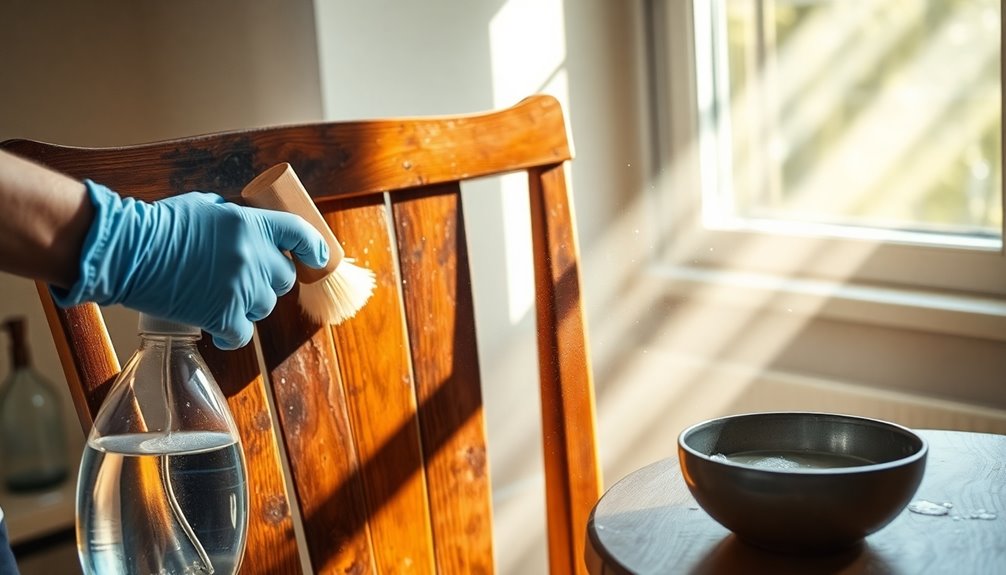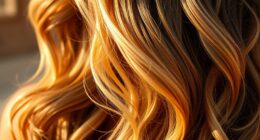To get rid of mold on furniture, start by wearing protective gear like gloves and a mask. Ensure good ventilation by opening windows. Use a HEPA filter vacuum to remove loose spores, sealing the bag tightly afterward. For cleaning, mix water and detergent for initial scrubbing, then apply a vinegar solution, letting it sit for an hour. For stubborn mold, try a 3% hydrogen peroxide solution or mild bleach mix. After cleaning, dry the furniture completely in a well-ventilated area to prevent regrowth. Maintaining low humidity levels will help prevent future mold issues, and there's more to discover.
Key Takeaways
- Identify the mold type and use protective gear, ensuring good ventilation during the cleanup process.
- Vacuum furniture with a HEPA filter vacuum to remove loose mold spores and dirt.
- Clean affected areas with a mild detergent solution, vinegar, or a 3% hydrogen peroxide solution for stubborn stains.
- Thoroughly dry cleaned surfaces and maintain indoor humidity below 60% to prevent mold regrowth.
- Regularly inspect and clean furniture to catch moisture issues early and consider using mold-resistant materials.
Preparation and Safety

When tackling mold on furniture, thorough preparation and safety measures are essential for effective cleaning and your well-being. First, identify the type of mold you’re dealing with; this will help you choose the right cleaning method. For light mold, a mixture of water and detergent works well. For tougher stains, diluted bleach is effective, but remember to avoid mixing any cleaning agents to prevent toxic fumes. A vinegar solution—equal parts vinegar and water—is great for wood finishes. Once you have removed the mold, it’s important to allow the furniture to dry completely to prevent future mold growth. If you’re planning to refinish the piece, make sure to learn how to prepare wood for staining, which involves sanding the surface and ensuring it is clean and free of any contaminants. Finally, consider applying a protective sealant after staining to enhance durability and resist moisture, keeping your furniture mold-free in the future.
Before you start, gear up with protective gloves, a respirator mask, and safety goggles to shield yourself from mold spores and chemicals. Wearing disposable coveralls and protective footwear adds an extra layer of safety. Ensure good ventilation by opening windows or using exhaust fans. Isolate the cleanup area to keep unprotected individuals away, and seal ventilation ducts to prevent spreading spores. Regular inspections for moisture and mold can also help you stay ahead of any potential issues.
Be cautious during cleaning; avoid direct contact with mold and refrain from inhaling spores. Ensure your workspace remains clean and dry throughout the process. Following these preparation and safety steps will protect you and make your cleaning efforts more effective.
Vacuuming and Initial Cleaning

Vacuuming is a crucial first step in tackling mold on furniture. Start by using a HEPA filter vacuum, which captures 99.97% of particles as small as 0.3 microns, including mold spores. Vacuum the entire surface of the furniture to remove loose mold and dirt effectively. Be sure to seal the vacuumed material in a plastic bag to prevent the spread of mold spores into your home. This precaution is vital before you apply any cleaning solutions, as it helps avoid further contamination.
Next, identify the type of mold and the furniture material. Isolate the affected area to keep spores from spreading to other parts of the furniture or your environment. Before proceeding with any cleaning method, check the manufacturer's instructions to ensure it won't damage the furniture. If you're unsure, test a small, less-visible area first. It is important to note that certain common mold types thrive in high humidity, which can affect your cleaning approach.
For light mold, you can prepare a mild solution of water and liquid detergent. Apply this using a soft-bristled brush or sponge, being careful not to saturate the material. Once you've vacuumed and done this initial cleaning, you're ready to move on to more intensive cleaning solutions.
Using Cleaning Solutions

After you've completed the initial cleaning, it's time to tackle the remaining mold with effective cleaning solutions. One option is a vinegar solution; mix one part vinegar with one part water, then apply it to the affected area using a spray bottle or sponge. Let it sit for about an hour before wiping it clean and allowing it to air dry. Maintaining a dry environment is crucial to preventing mold growth on your furniture.
For stubborn mold stains, consider using a 3% hydrogen peroxide solution. Apply it directly to the stains, let it sit for a few minutes, and gently scrub if necessary, then wipe clean. Ensure the fabric is completely dry before using the furniture again.
If the mold is deeply embedded, a bleach solution might be your best bet. Mix a ratio of 1:10:20 of detergent, bleach, and warm water, or use 8 ounces of bleach with 2 ounces of laundry detergent per gallon of water. Apply and let it soak for 15 minutes before scrubbing and rinsing thoroughly.
Alternatively, mix rubbing alcohol with water in a 1:1 ratio or dilute tea tree oil with water for a natural approach. Always test any solution on a small area first to avoid damage.
Specialized Cleaning Methods

For effective mold removal on furniture, specialized cleaning methods can significantly enhance your results. Start by using a vacuum equipped with a HEPA filter. This will help extract mold spores from fabric furniture. Attach the brush to gently agitate the mold, allowing the vacuum to capture more spores. After vacuuming, discard the bag to prevent spore proliferation.
Consider dry ice blasting, a chemical-free technique perfect for removing mold without health risks or lingering odors. It's safe for various materials and allows immediate reoccupation of the cleaned area. Additionally, maintaining indoor humidity below 60% is crucial to preventing future mold growth on furniture.
For mold on wood surfaces, wire brushing and sanding can be effective. Use wire brushing for small areas and employ sanding to uproot mold, but leave sanding to professionals to avoid harmful exposure. Follow up with the HEPA vacuum for thorough cleaning.
Finally, isolate the contaminated area. Hang plastic sheets over windows and doors to contain airborne spores, and double-bag contaminated materials. Always wear high-grade safety gear like gloves and goggles during this process. With these specialized methods, you'll tackle mold effectively and keep your furniture safe.
Drying and Ventilation

Cleaning mold from furniture is only part of the solution; drying and proper ventilation play a vital role in preventing its return. Start by exposing your fabric furniture to sunlight. The UV rays not only kill surface mold but also inhibit future growth, especially in well-ventilated areas. Direct sunlight can effectively dry and disinfect your furniture after cleaning, so take advantage of it whenever possible.
Next, ensure good ventilation to speed up the drying process. Open windows and doors to promote air circulation, and consider using fans to enhance airflow. This helps reduce moisture accumulation and limits exposure to mold spores and cleaning fumes. For fabric furniture, use dry cloths to remove excess moisture, and blot upholstery thoroughly to ensure it dries completely before using it again. Additionally, be aware that indoor humidity levels above 60% can significantly increase the risk of mold growth, so it is important to maintain them within a safe range.
When dealing with wood furniture, allow it to air dry in a well-ventilated area, avoiding direct heat sources or sunlight to prevent warping. Additionally, maintain indoor humidity levels between 30% and 50% using dehumidifiers, and promptly address any spills or leaks to keep mold at bay. Regularly inspect your space to improve air circulation and minimize moisture.
Post-Cleaning Maintenance

Maintaining a dry environment is crucial to preventing mold from returning to your furniture. Use dehumidifiers to keep humidity levels between 30% and 50%, and regularly check for water leaks. Position your furniture away from damp areas like leaky windows or basements, and ensure there's enough space between your furniture and walls to promote air circulation. You can also place moisture-absorbing materials, like silica gel packets or activated charcoal, near your furniture. Keeping an eye on poor ventilation can help you address potential mold risks before they escalate.
Regular cleaning and inspection are equally important. Dust your furniture with a microfiber cloth and vacuum upholstery with a brush attachment to eliminate mold spores. Inspect your furniture frequently for signs of moisture or mold growth. If you notice any issues, use a mixture of dish soap and warm water or distilled white vinegar to clean the affected areas.
To further protect your furniture, consider applying varnish or sealant to wooden surfaces. In humid environments, use moisture-resistant coatings and barriers. Don't forget to promote healthy living conditions by ensuring proper ventilation and allowing your furniture to receive direct sunlight. Following these steps will significantly help in maintaining your furniture and keeping mold at bay.
Frequently Asked Questions
Can Mold on Furniture Affect My Health?
Yes, mold on furniture can affect your health. Inhaling or touching mold can trigger allergic reactions like sneezing and skin rashes, even if you don't have a mold allergy. If you have asthma or a weakened immune system, you might experience more severe reactions, including asthma attacks or lung infections. The type of mold present and the duration of exposure play significant roles in determining your risk, so addressing any mold issues promptly is crucial.
What Types of Furniture Are Most Susceptible to Mold?
Upholstered furniture, like couches and chairs, is particularly susceptible to mold due to its moisture-absorbing fabric. Mattresses and foam pillows are also at risk, often harboring mold from trapped sweat and humidity. Wooden furniture can develop surface molds if moisture content rises. Remember, high humidity and poor ventilation can create ideal conditions for mold growth on all types of furniture, so it's essential to keep your living spaces dry and well-ventilated.
How Can I Prevent Mold Growth on My Furniture?
To prevent mold growth on your furniture, control humidity by keeping indoor levels between 30% and 50%. Use dehumidifiers and air conditioners, and monitor with a hygrometer. Improve ventilation by moving furniture away from walls and using fans. Maintain cleanliness by regularly dusting and vacuuming. Lastly, prevent water damage by promptly repairing leaks, wiping up spills, and applying moisture-resistant coatings to wooden pieces. These steps will help keep your furniture mold-free.
Is It Safe to Use Essential Oils for Mold Removal?
Yes, it's safe to use essential oils for mold removal if you take proper precautions. Oils like tea tree, thyme, and clove have strong antimicrobial properties that effectively combat mold. Just make sure to dilute them appropriately to avoid irritation or damage to surfaces. Always test a small area first. While they're natural alternatives to harsh chemicals, severe mold infestations might still require professional remediation for complete removal.
When Should I Call a Professional for Mold Removal?
You should call a professional for mold removal when the affected area exceeds 10 square feet, as it can be challenging to contain spores. If you suspect hidden mold inside walls or HVAC systems, it's crucial to get expert help. If you're experiencing health issues like asthma or allergies, don't hesitate to reach out. Additionally, extensive water damage or high humidity levels signal the need for professional assessment and remediation.
Conclusion
By following these steps, you can effectively get rid of mold on your furniture. Always prioritize safety during the cleaning process and ensure proper ventilation to prevent future growth. Regularly inspect your furniture and maintain a dry environment to keep mold at bay. With a little effort, you can restore your furniture's beauty and protect your home from the harmful effects of mold. Don't let mold take over—stay proactive and enjoy a healthier living space!









